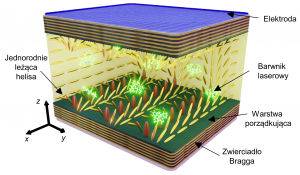A team of researchers from the Faculty of Physics at the University of Warsaw, the Military University of Technology, and the Institut Pascal at Université Clermont Auvergne has developed a novel method for using cholesteric liquid crystals in optical microcavities. The results of the research have been published in the renowned journal “Laser & Photonics Reviews”.
“A uniform lying helix (ULH) structure of a cholesteric phase liquid crystal is arranged in the optical cavity. The self-organised helix structure with the axis lying in the plane of the cavity acts as a one-dimensional periodic photonic lattice. This is possible due to the unique properties of liquid crystals, which are elongated molecules that resemble a pencil,” explains Prof. Jacek Szczytko from the Faculty of Physics at the University of Warsaw, where research on novel optical microcavities is being conducted.
“A cholesteric structure is a spiral structure made up of layers of almost parallel oriented molecules lying in a single plane. From layer to layer, the orientation of the molecules is gently twisted, which altogether builds up a helical structure reminiscent of DNA helixes or ‘piggyback’ noodles. The direction perpendicular to the layers of molecules determines the axis of the helix formed. It turns out that when such a structure is observed in the direction perpendicular to the axis of the helix under appropriate illumination, distinct stripes with a width equal to the helix pitch are noticed. The use of liquid crystals that respond to an electric field enables precise control of this pitch, and thus of the structure of the photonic bands, opening up new perspectives in photonic engineering,” adds Prof Szczytko.
The effects described are made possible by the use of optical microcavity, which restricts the movement of light in one dimension, giving it properties similar to particles endowed with mass. In the cavity, photons that have no rest mass start to behave like massive particles. Adding a photonic potential in space with a given period associated with a helix jump extends this analogy and allows further manipulation of these properties.

Tunable photonic crystal based on a self-organized liquid crystal structure in an optical microcavity (drawing by Marcin Muszyński, Faculty of Physics, University of Warsaw).
Light with the properties of matter
“The goal of our research is to discover how light can acquire properties normally attributed to matter while retaining its unique characteristics,” says Prof Jacek Szczytko.
The optical microcavities were fabricated by researchers from the Military University of Technology, in Prof. Wiktor Piecek’s group, using helical structures created by Prof. Eva Oton in cavities fabricated by Dr Przemysław Morawiak and Dr Rafał Mazur.
“For years, scientists have been developing nano- and microstructures that modulate the properties of the light that interacts with them,” explains Marcin Muszyński, first author of the paper and a doctoral candidate carrying out research at the UW Faculty of Physics
“However, typical technologies for producing photonic crystals have several drawbacks: their manufacture is technologically complex and therefore expensive and time-consuming. Our work solves these problems – the structures created by self-organisation have a surface area in the order of hundreds of square micrometres, and thanks to the reorientation of the liquid crystal molecules in an electric field, we can dynamically control the band structure of the light trapped in the microcavity.” adds Marcin Muszyński
Results of the research open the door to applications in topological photonics and modern laser technologies.
Scientific publication:
Marcin Muszyński, Przemysław Oliwa, Pavel Kokhanchik, Piotr Kapuściński, Eva Oton, Rafał Mazur, Przemysław Morawiak, Wiktor Piecek, Przemysław Kula, Witold Bardyszewski, Barbara Piętka, Daniil Bobylev, Dmitry Solnyshkov, Guillaume Malpuech, Jacek Szczytko Electrically Tunable Spin-Orbit Coupled Photonic Lattice in a Liquid Crystal Microcavity, “Laser Photonics Rev.” 19(7)/2025)